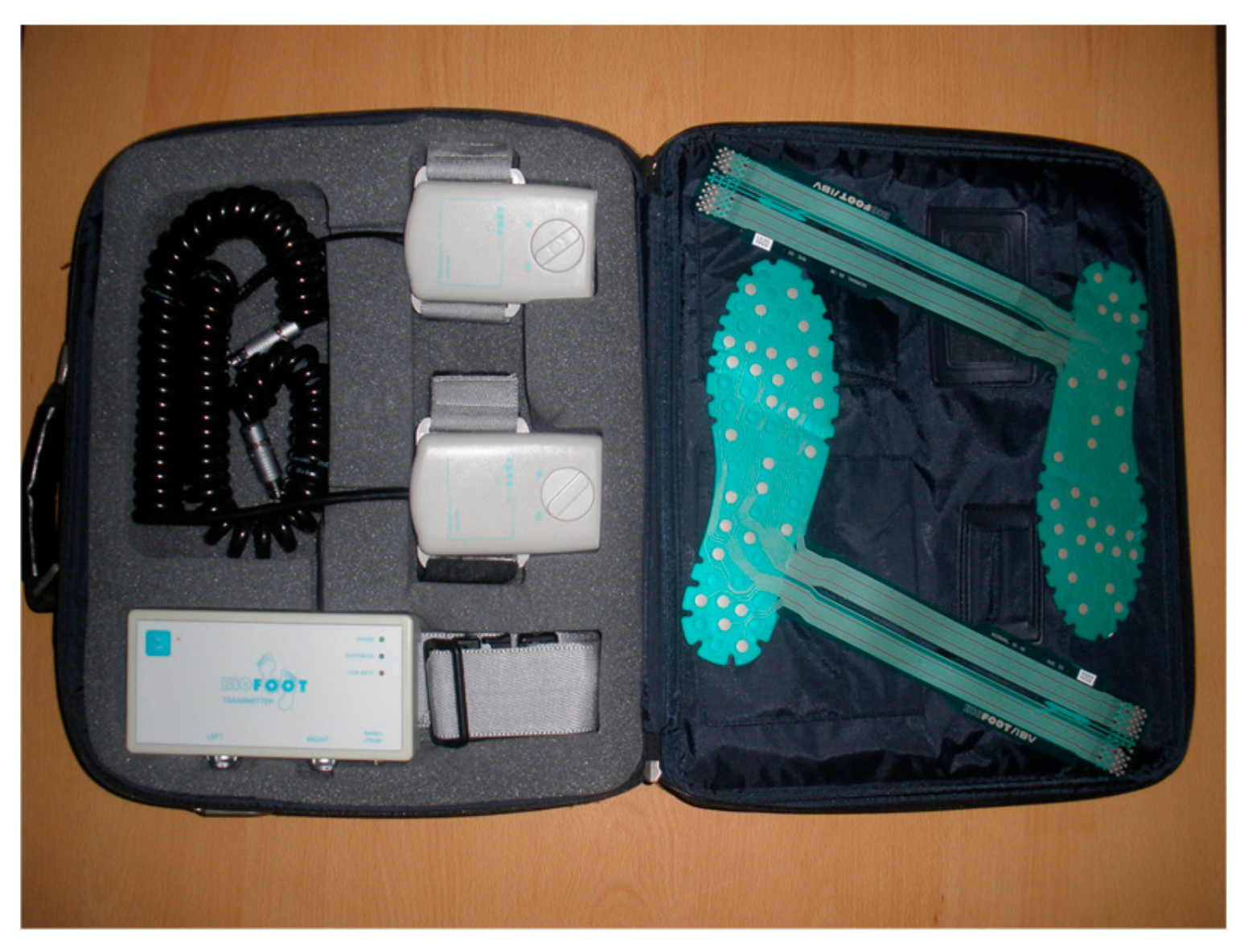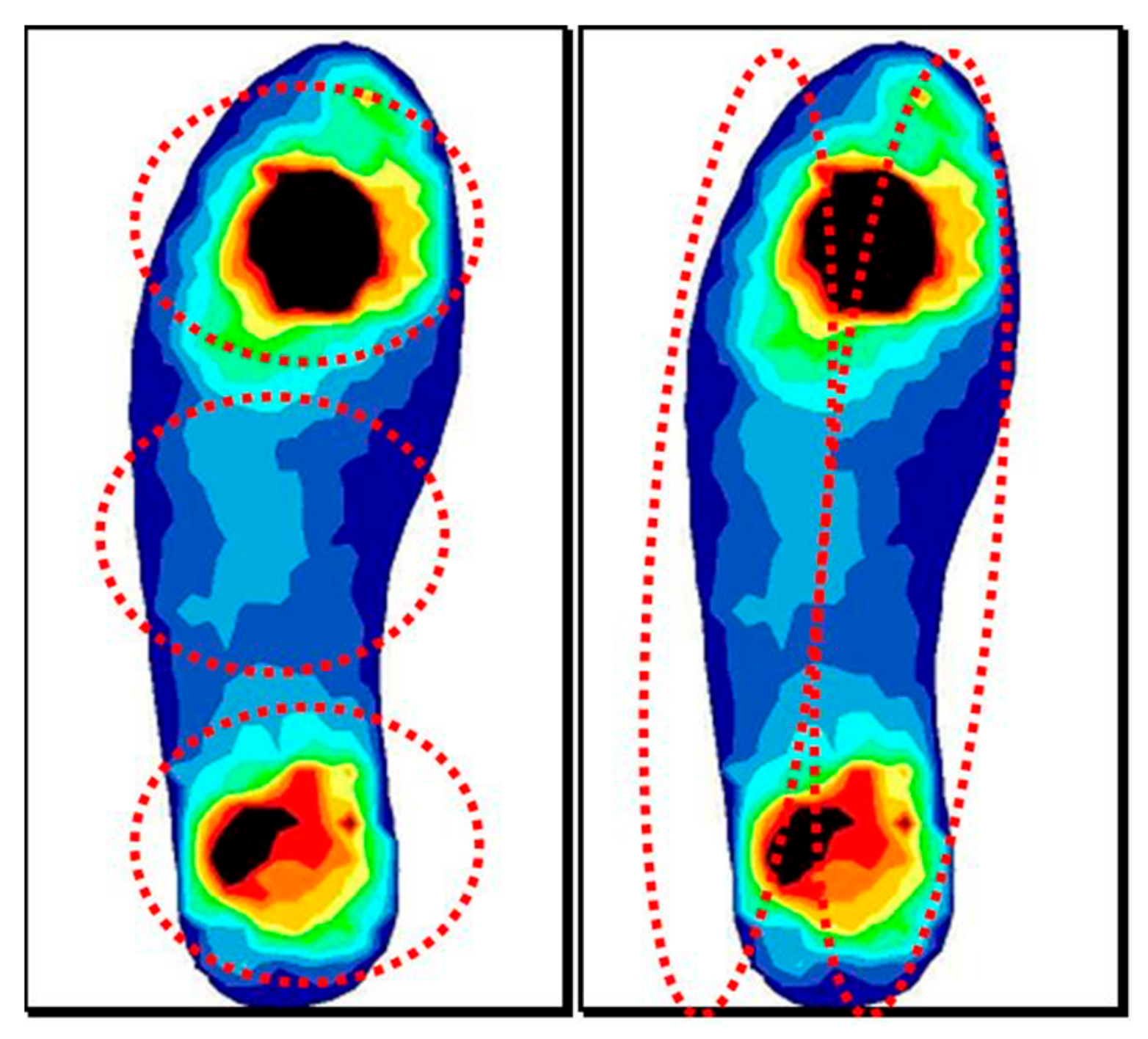Longitudinal Analysis of Plantar Pressures with Wear of a Running Shoe
Abstract
1. Introduction
2. Materials and Methods
2.1. Subjects
2.2. Protocol
2.3. Plantar Pressures Measurement
2.4. Statistical Analysis
3. Results
3.1. Plantar Pressures
3.2. Perceived Cushioning
4. Discussion
Limitations of the Study
5. Conclusions
Author Contributions
Funding
Conflicts of Interest
References
- Kozlovskaia, M.; Vlahovich, N.; Rathbone, E.; Manzanero, S.; Keogh, J.; Hughes, D.C. A profile of health, lifestyle and training habits of 4720 Australian recreational runners—The case for promoting running for health benefits. Health Promot. J. Austr. 2019, 30, 172–179. [Google Scholar] [CrossRef] [PubMed]
- Huang, L.; Liu, Y.; Wei, S.; Li, L.; Fu, W.; Sun, Y.; Feng, Y. Segment-interaction and its relevance to the control of movement during spring. J. Biomech. 2013, 46, 2018–2023. [Google Scholar] [CrossRef] [PubMed]
- Storen, O.; Helgerud, J.; Hoff, J. Running stride peak forces inversely determine running economy in elite runners. J. Strength. Cond. Res. 2010, 25, 117–123. [Google Scholar] [CrossRef]
- Hollander, K.; Zech, A.; Rahlf, A.L.; Orendurff, M.S.; Stebbins, J.; Heidt, C. The relationship between static and dynamic foot posture and running biomechanics: A systematic review and meta-analysis. Gait Posture 2019, 72, 109–122. [Google Scholar] [CrossRef]
- Bus, S.A. Ground reaction forces and kinematics in distance running in older-aged men. Med. Sci. Sports Exerc. 2003, 35, 1167–1175. [Google Scholar] [CrossRef] [PubMed]
- Gimunová, M.; Zvonař, M.; Mikeska, O. The effect of aging and gender on plantar pressure distribution during the gait in elderly. Acta Bioeng. Biomech. 2018, 20, 139–144. [Google Scholar]
- Fu, W.; Fang, Y.; Ming, D.; Liu, S.; Wang, L.; Ren, S.; Liu, Y. Surface effects on in-shoe plantar pressure and tibial impact during running. J. Sport Health Sci. 2015, 4, 384–390. [Google Scholar] [CrossRef]
- Tessutti, V.; Ribeiro, A.P.; Trombini-Souza, F.; Sacco, I.C. Attenuation of foot pressure during running on four different surfaces: Asphalt, concrete, rubber, and natural grass. J. Sports Sci. 2012, 30, 1545–1550. [Google Scholar] [CrossRef]
- Lussiana, T.; Hébert-Losier, K.; Millet, G.P.; Mourot, L. Biomechanical changes during a 50-min run in different footwear and on various slopes. J. Appl. Biomech. 2016, 32, 40–49. [Google Scholar] [CrossRef]
- Nigg, B.; Hintzen, S.; Ferber, R. Effect of an unstable shoe construction on lower extremity gait characteristics. Clin. Biomech. 2006, 21, 82–88. [Google Scholar] [CrossRef]
- Morio, C.; Lake, M.J.; Gueguen, N.; Rao, G.; Baly, L. The influence of footwear on foot motion during walking and running. J. Biomech. 2009, 42, 2081–2088. [Google Scholar] [CrossRef] [PubMed]
- Maiwald, C.; Grau, S.; Krauss, I.; Mauch, M.; Axmann, D.; Horstmann, T. Reproducibility of plantar pressure distribution data in barefoot running. J. Appl. Biomech. 2008, 24, 14–23. [Google Scholar] [CrossRef] [PubMed]
- Mei, Q.; Gu, Y.; Xiang, L.; Yu, P.; Gao, Z.; Shim, V.; Fernandez, J. Foot shape and plantar pressure relationships in shod and barefoot populations. Biomech. Model. Mechanobiol. 2019, 9, 1–14. [Google Scholar] [CrossRef] [PubMed]
- Braunstein, B.; Arampatzis, A.; Eysel, P.; Bruggemann, G.P. Footwear affects the gearing at the ankle and knee joints during running. J. Biomech. 2010, 43, 2120–2125. [Google Scholar] [CrossRef]
- Lieberman, D.E.; Venkadesan, M.; Werbel, W.A.; Daoud, A.I.; D’Andrea, S.; Davis, I.S.; Mang’Eni, R.O.; Pitsiladis, Y. Foot strike patterns and collision forces in habitually barefoot versus shod runners. Nature 2010, 463, 531–535. [Google Scholar] [CrossRef]
- Roca-Dols, A.; Losa-Iglesias, M.E.; Sánchez-Gómez, R.; Becerro-de-Bengoa-Vallejo, R.; López-López, D.; Rodríguez-Sanz, D.; Martínez-Jiménez, E.M.; Calvo-Lobo, C. Effect of the cushioning running shoes in ground contact time of phases of gait. J. Mech. Behav. Biomed. Mater. 2018, 88, 196–200. [Google Scholar] [CrossRef]
- Barnes, A.; Wheat, J.; Milner, C.E. Use of gait sandals for measuring rearfoot and shank motion during running. Gait Posture 2010, 1, 133–135. [Google Scholar] [CrossRef]
- Birrer, R.B.; Buzermanis, S.; Dellacorte, M.P.; Grisalfi, P.J. Biomechanics of Running. In Textbook of Running Medicine; O’Connor, B.L., Wilder, R.P., Nirschl, R., Eds.; McGraw Hill: New York, NY, USA, 2001. [Google Scholar]
- Teh, J.; Suppiah, R.; Sharp, R.; Newton, J. Imaging in the assessment and management of overuse injuries in the foot and ankle. Semin. Musculoskelet. Radiol. 2011, 1, 101–114. [Google Scholar] [CrossRef]
- Clinghan, R.; Arnold, G.P.; Cochrane, L.; Drew, T.S.; Abboud, R.J. The use of in-shoe pressure analysis in the evaluation of running shoes. Clin. Biomech. 2008, 23, 668–669. [Google Scholar] [CrossRef]
- Wegener, C.; Burns, J.; Penkala, S. Effect of neutral-cushioned running shoes on plantar pressure loading and comfort in athletes with cavus feet: A crossover randomized controlled trial. Am. J. Sports Med. 2008, 36, 2139–2146. [Google Scholar] [CrossRef]
- Even-Tzur, N.; Weisz, E.; Hirsch-Falk, Y.; Gefen, A. Role of EVA viscoelastic properties in the protective performance of a sport shoe: Computational studies. Biomed. Mater. Eng. 2006, 16, 289–299. [Google Scholar] [PubMed]
- Wiegerinck, J.I.; Boyd, J.; Yoder, J.C.; Abbey, A.N.; Nunley, J.A.; Queen, R.M. Differences in plantar loading between training shoes and racing flats at a self-selected running speed. Gait Posture 2009, 29, 514–519. [Google Scholar] [CrossRef] [PubMed]
- Dixon, S.J. Use of pressure insoles to compare in-shoe loading for modern running shoes. Ergonomics 2008, 51, 1503–1514. [Google Scholar] [CrossRef] [PubMed]
- Verdejo, R.; Mills, N.J. Heel-shoe interactions and the durability of EVA foam running-shoe midsoles. J. Biomech. 2004, 37, 1379–1386. [Google Scholar] [CrossRef] [PubMed]
- Kong, P.W.; Candelaria, N.G.; Smith, D.R. Running in new and worn shoes: A comparison of three types of cushioning footwear. Br. J. Sports Med. 2009, 43, 745–749. [Google Scholar] [CrossRef]
- Martínez-Nova, A.; Cuevas-García, J.C.; Pascual-Huerta, J.; Sánchez-Rodríguez, R. BioFoot® in-shoe system: Normal values and assessment of the reliability and repeatability. Foot 2007, 17, 190–196. [Google Scholar] [CrossRef]
- Orlin, M.N.; McPoil, T.G. Plantar pressure assessment. Phys. Ther. 2000, 80, 399–409. [Google Scholar] [CrossRef]
- Morley, J.B.; Decker, L.M.; Dierks, T.; Blanke, D.; French, J.A.; Stergiou, N. Effects of varying amounts of pronation on the mediolateral ground reaction forces during barefoot versus shod running. J. Appl. Biomech. 2010, 26, 205–214. [Google Scholar] [CrossRef]
- Goto, A.; Moritomo, H.; Itohara, T.; Watanabe, T.; Sugamoto, K. Three dimensional in vivo kinematics of the subtalar joint during dorsi-plantarflexion and inversion-eversion. Foot. Ankle Int. 2009, 5, 432–438. [Google Scholar]
- Behling, A.V.; Manz, S.; von Tscharner, V.; Nigg, B.M. Pronation or foot movement—What is important. J. Sci. Med. Sport 2020, 24, 366–371. [Google Scholar] [CrossRef]
- Teyhen, D.S.; Stoltenberg, B.E.; Eckard, T.G.; Doyle, P.M.; Boland, D.M.; Feldtmann, J.J.; McPoil, T.; Christie, D.S.; Molloy, J.M.; Goffar, S.L. Static foot posture associated with dynamic plantar pressure parameters. J. Orthop. Sports Phys. Ther. 2011, 41, 100–107. [Google Scholar] [CrossRef] [PubMed]
- Chuckpaiwong, B.; Nunley, J.A.; Mall, N.A.; Queen, R.M. The effect of foot type on in-shoe plantar pressure during walking and running. Gait Posture 2008, 28, 405–411. [Google Scholar] [CrossRef] [PubMed]
- Chevalier, T.L.; Hodgins, H.; Chockalingan, N. Plantar pressure measurements using an in-shoe system and a pressure platform: A comparison. Gait Posture 2010, 31, 397–399. [Google Scholar] [CrossRef] [PubMed]
- Mills, N.J.; Rodríguez-Pérez, M.A. Modelling the gas-loss creep mechanism in EVA foam from running shoes. Cell. Polym. 2001, 20, 79–100. [Google Scholar] [CrossRef]
- Roca-Dols, A.; Elena Losa-Iglesias, M.; Sánchez-Gómez, R.; Becerro-de-Bengoa-Vallejo, R.; López-López, D.; Palomo-López, P.; Rodríguez-Sanz, D.; Calvo-Lobo, C. Electromyography activity of triceps surae and tibialis anterior muscles related to various sports shoes. J. Mech. Behav. Biomed. Mater. 2018, 86, 158–171. [Google Scholar] [CrossRef]
- Roca-Dols, A.; Losa-Iglesias, M.E.; Sánchez-Gómez, R.; López-López, D.; Becerro-de-Bengoa-Vallejo, R.; Calvo-Lobo, C. Electromyography comparison of the effects of various footwear in the activity patterns of the peroneus longus and brevis muscles. J. Mech. Behav. Biomed. Mater. 2018, 82, 126–132. [Google Scholar] [CrossRef]
- Burns, J.; Keenan, A.M.; Redmond, A. Foot type and overuse injury in triathletes. J. Am. Podiatr. Med. Assoc. 2005, 95, 235–241. [Google Scholar] [CrossRef]
- Queen, R.M.; Abbey, A.N.; Wiegerinck, J.I.; Yoder, J.C.; Nunely, J.C. Effect of shoe type on plantar pressure: A gender comparison. Gait Posture 2009, 31, 18–22. [Google Scholar] [CrossRef]
- Hennig, E.M.; Milani, T.L. Pressure distribution measurements for evaluation of running shoe properties. Sportverletz. Sportschaden 2000, 14, 90–97. [Google Scholar] [CrossRef]
- Fields, K.B.; Sykes, J.C.; Walker, K.M.; Jackson, J.C. Prevention of running injuries. Curr. Sports Med. Rep. 2010, 9, 176–182. [Google Scholar] [CrossRef]
- Taunton, J.E.; Ryan, M.B.; Clement, D.B.; McKenzie, D.C.; Lloyd-Smith, D.R.; Zumbo, B.D. A prospective study of running injuries: The Vancouver Sun Run “in training” clinics. Br. J. Sports Med. 2003, 37, 239–244. [Google Scholar] [CrossRef] [PubMed]
- Cornwall, M.W.; McPoil, T.G. Can Runners perceive changes in heel cushioning as the shoe ages with increased mileage? Int. J. Sports Phys. Ther. 2017, 12, 616–624. [Google Scholar] [PubMed]


| Variable | Measurement 1 | Measurement 2 | Measurement 3 | p |
|---|---|---|---|---|
| Mean ± SD | Mean ± SD | Mean ± SD | ||
| Contact time (s) | 0.32 ± 0.08 | 0.3 ± 0.08 | 0.33 ± 0.07 | 0.582 |
| Cadence (steps/min) | 161.9 ± 30.8 | 148.2 ± 30.6 | 158.3 ± 37.6 | 0.610 |
| Lateral peak pressure (kPa) | 766.1 ± 465.2 | 787.6 ± 497.8 | 838.1 ± 508.6 | 0.501 |
| Medial peak pressure (kPa) | 969.2 ± 504.4 | 1023.8 ± 478.8 | 1052.7 ± 543.4 | 0.476 |
| Rearfoot peak pressure (kPa) | 639.9 ± 506 | 767.7 ± 438.4 | 773.9 ± 656.9 | 0.238 |
| Midfoot peak pressure (kPa) | 387.8 ± 205.3 | 450.3 ± 297.4 | 590 ± 457.6 | 0.027 |
| Forefoot peak pressure (kPa) | 884.6 ± 554.7 | 913.6 ± 548.2 | 998.5 ± 564.8 | 0.329 |
| Variables | r | p | |
|---|---|---|---|
| N = 33 | |||
| MPP rearfoot | Cushioning rearfoot | −0.265 | 0.136 |
| MPP midfoot | Cushioning midfoot | −0.513 | 0.002 |
| MPP forefoot | Cushioning forefoot | −0.287 | 0.106 |
| MPP rearfoot | Overall score | −0.332 | 0.059 |
| MPP midfoot | Overall score | −0.417 | 0.016 |
| MPP forefoot | Overall score | −0.301 | 0.083 |
| MPP maximum peak pressure; Pearson correlation. | |||
© 2020 by the authors. Licensee MDPI, Basel, Switzerland. This article is an open access article distributed under the terms and conditions of the Creative Commons Attribution (CC BY) license (http://creativecommons.org/licenses/by/4.0/).
Share and Cite
Escamilla-Martínez, E.; Gómez-Martín, B.; Fernández-Seguín, L.M.; Martínez-Nova, A.; Pedrera-Zamorano, J.D.; Sánchez-Rodríguez, R. Longitudinal Analysis of Plantar Pressures with Wear of a Running Shoe. Int. J. Environ. Res. Public Health 2020, 17, 1707. https://doi.org/10.3390/ijerph17051707
Escamilla-Martínez E, Gómez-Martín B, Fernández-Seguín LM, Martínez-Nova A, Pedrera-Zamorano JD, Sánchez-Rodríguez R. Longitudinal Analysis of Plantar Pressures with Wear of a Running Shoe. International Journal of Environmental Research and Public Health. 2020; 17(5):1707. https://doi.org/10.3390/ijerph17051707
Chicago/Turabian StyleEscamilla-Martínez, Elena, Beatriz Gómez-Martín, Lourdes María Fernández-Seguín, Alfonso Martínez-Nova, Juan Diego Pedrera-Zamorano, and Raquel Sánchez-Rodríguez. 2020. "Longitudinal Analysis of Plantar Pressures with Wear of a Running Shoe" International Journal of Environmental Research and Public Health 17, no. 5: 1707. https://doi.org/10.3390/ijerph17051707
APA StyleEscamilla-Martínez, E., Gómez-Martín, B., Fernández-Seguín, L. M., Martínez-Nova, A., Pedrera-Zamorano, J. D., & Sánchez-Rodríguez, R. (2020). Longitudinal Analysis of Plantar Pressures with Wear of a Running Shoe. International Journal of Environmental Research and Public Health, 17(5), 1707. https://doi.org/10.3390/ijerph17051707






